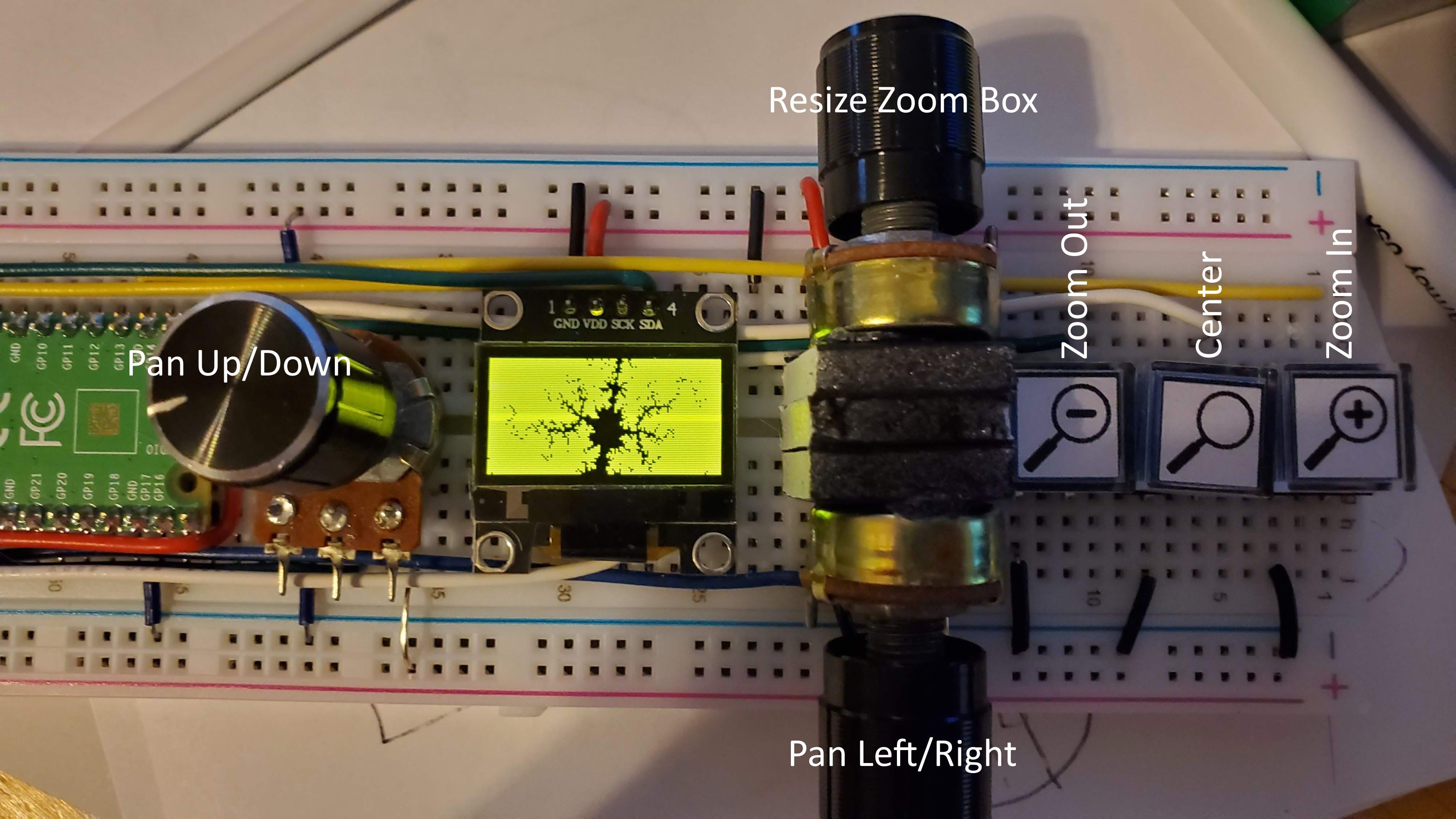CircuitPython code is below.
First CircuitPython version: https://github.com/hwiguna/PicoMandelbrot
Latest MicroPython version: https://github.com/hwiguna/HariFun_202_MandelbrotPico
Every platform needs a Mandelbrot
To make the experience fit your profile, pick a username and tell us what interests you.
We found and based on your interests.
CircuitPython code is below.
First CircuitPython version: https://github.com/hwiguna/PicoMandelbrot
Latest MicroPython version: https://github.com/hwiguna/HariFun_202_MandelbrotPico
I added another button to toggle between hires and lores.
I also converted the code to MicroPython. I think it's faster, but I never did a speed comparison.
Code is on GitHub:

Added three potentiomenters and three pushbuttons to navigate the Mandelbrot.
MAX_ITER = 80
def mandelbrot(c):
z,n = 0,0
while abs(z) <= 2 and n < MAX_ITER:
z = z*z + c
n += 1
return n# Mandelbrot adapted for Pi Pico by Hari Wiguna from:
# https://www.codingame.com/playgrounds/2358/how-to-plot-the-mandelbrot-set/mandelbrot-set
def main():
import board # Pi Pico Board GPIO pins
import displayio # Python's multi layer graphics
import adafruit_displayio_ssd1306 # OLED Driver
import busio # Provides I2C support
import time
from adafruit_display_shapes.line import Line
import math
from hari.mandelbrot import mandelbrot, MAX_ITER
WIDTH, HEIGHT = 128, 64 #32 # Change to 64 if needed
displayio.release_displays() # Just to be safe
def SetupDisplay():
# So we can communicate with our OLED via I2C
i2c = busio.I2C(scl=board.GP3, sda=board.GP2)
#while not i2c.try_lock():
# pass
#print("i2c address is = ",i2c.scan())
# How displayio talks to physical screen
display_bus = displayio.I2CDisplay(i2c, device_address=60) # was 0x3A, reset=oled_reset)
# display represents the physical screen
display = adafruit_displayio_ssd1306.SSD1306(display_bus, width=WIDTH, height=HEIGHT, auto_refresh=False)
# Group is a list of TileGrids that display would render on physical screen
group = displayio.Group(max_size=1)
display.show(group)
return (display, group)
def SetupTileGrid():
#-- Create a bitmap --
bitmap = displayio.Bitmap(WIDTH, HEIGHT, 2)
#-- Create Palette --
palette = displayio.Palette(2)
palette[0] = 0
palette[1] = 0xFFFFFF
#-- Create TileGrid --
tileGrid = displayio.TileGrid(bitmap, pixel_shader=palette)
return bitmap, tileGrid
#=== MAIN ===
(mDisplay, mGroup) = SetupDisplay()
(mBitmap, mTileGrid) = SetupTileGrid()
mGroup.append(mTileGrid) #add the TileGrid to the group
RE_START = -1.5 #-2
RE_END = -1 #1
IM_START = -.25 #-1
IM_END = .25 #1
xOffset = -0.8
RE_START = -2 + xOffset
RE_END = 2 + xOffset
IM_START = -1
IM_END = 1
MAX_ITER = 80
for x in range(0, WIDTH):
xx = RE_START + (x / WIDTH) * (RE_END - RE_START)
for y in range(0, HEIGHT):
yy = IM_START + (y / HEIGHT) * (IM_END - IM_START)
c = complex(xx, yy) # Convert pixel coordinate to complex number
m = mandelbrot(c) # Compute the number of iterations
color = 1 - int(m/MAX_ITER)
if color>0: mBitmap[x,y] = 1 # Plot the point
if x % 4 == 0: mDisplay.refresh()
mDisplay.refresh()
while True:
pass
Create an account to leave a comment. Already have an account? Log In.
I agree -- every platform needs a Brot. Nice job here.
I stumbled across a Mandelbrot generator made completely with logic gates. It was done entirely within a logic simulator, but it should be possible to build a hardware version from discrete 74xx series chips. I'd dearly love to do that.
Watch for this week's Link's article for more info.
Become a member to follow this project and never miss any updates
By using our website and services, you expressly agree to the placement of our performance, functionality, and advertising cookies. Learn More
OMG! That's impossible!? I suppose, it's "just" a specialized version of discrete logic computers. Looking forward to the article.